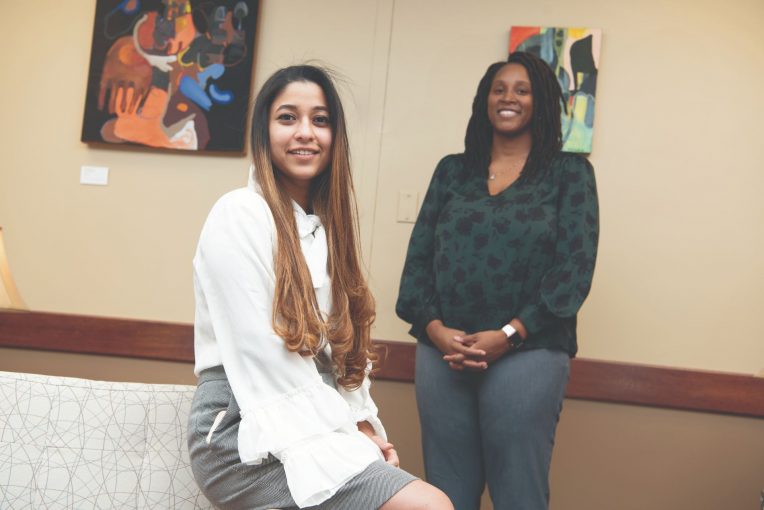As the movement for social justice and racial equity reached a critical point following the death of George Floyd last May, Khyati Verma, M.S. ’20, completed her master’s thesis on the impact of colorblind racial attitudes and implicit bias.
“The whole concept of colorblindness is that people are saying, ‘We don’t see race; we don’t think that race has any effect on an individual’s social standing or their overall success,’” said Verma, who studied developmental psychology at Illinois State. “That way of thinking is really a problem in today’s world.”
Appears InVerma grew up in New Delhi, India, where she received her bachelor’s degree in psychology and master’s degree in clinical psychology from the University of Delhi. She was initially inspired to focus her master’s thesis on inequity after a class reading that helped her make a connection to her experience with the caste system in India.
“During one of my classes my first semester, we were asked to write a paper and I came across this idea of colorblind attitudes,” said Verma. “I read that in-depth, and I realized that this is a concept that is very prevalent back home. Except in India, it is the caste system. People in India will say, ‘We don’t acknowledge caste.’”
“I have grown a lot as a researcher, as someone who understands social problems, and as someone who’s an advocate of social justice.”
Khyati Verma
Following this breakthrough, Verma educated herself on the social justice issues that are present in the United States. She received support from her thesis chair, Assistant Professor of Psychology Dr. Brea Banks. Banks researches minoritized student experiences and the consequences of microaggressions.
“At the start, we had many conversations about issues relevant to diversity, inclusion, and equity,” said Banks. “Those conversations were really integral in formulating the initial study.”
Initially, Verma planned to assess the prevalence of colorblind racial attitudes and implicit bias within white preservice teachers, and ultimately, how those attitudes might impact their future students’ learning.
“Implicit bias is an unconscious, automatic view that we hold about certain groups or communities that is based on how we’ve seen those groups,” said Verma. “It is typically influenced by our environment, our family, and through the media, to a large extent. It helps us to make quick decisions in a situation where we are not aware of what to do.”
However, the design of Verma’s study had to be altered as she was preparing to conduct the research last March due to the onset of coronavirus (COVID-19) restrictions. She had planned to do in-person interviews—which she felt would have yielded more accurate findings—but she ultimately chose an online survey. Due to lack of time for data collection, Verma had to open to students of all majors. A total of 258 participants completed the online survey, but Verma analyzed data only from the 198 white participants.
“There were 10 scenarios that were displayed to the participant. They were common classroom behaviors that are problematic in nature, like a student throwing a pencil or talking out of turn,” Verma explained. “These scenarios were accompanied with a photo of either a white boy or a Black boy. Each participant had to rate the 10 scenarios on the severity of the problem that the child was displaying and the severity of the punishment that they thought was appropriate for that child.”
In her study, Verma implemented the Color-Blind Racial Attitudes Scale (Co-BRAS) and the Implicit Association Test (IAT). The CoBRAS is a 20-item instrument that “measures the extent to which racism is ignored or denied by an individual,” whereas the IAT is used to “reveal attitudes and other automatic associations about specific groups.”
Verma hypothesized that problem behaviors would be rated higher for Black boys than for white boys, therefore making Black boys’ punishments more severe. Further, Verma hypothesized that the relation between attitudes and ratings would be stronger for participants assigned to Black boys.
“This study did not yield what we had hypothesized,” said Verma. “There were a lot of reasons, but something that really stood out was the fact that colorblind attitudes were only marginally significant to punishments and ratings.”
Despite this, Verma feels that her study has the potential to inspire and direct future research.
“I know my findings are insignificant, but one thing I would want to emphasize is that covert prejudice and discrimination is a real problem,” said Verma. “The data and the analysis of this study do not really suggest the prevalence of this issue, possibly as a result of participants responding in a socially desirable manner, but more research can be done in this area—particularly with a more heterogeneous population.”
Banks echoed the importance of this research. “We have to continue to examine how teachers are trained, particularly out of concern for the well-being and functioning of Black children and adolescents,” said Banks. “There’s a great deal of research out there that demonstrates that Black kids are treated differently in classrooms. I think that we have to continue to be diverse and versatile in the way that we conduct our research.”
After working with her for a year, Banks is proud of Verma’s personal growth and her resilience throughout the roadblocks of the research process. “Khyati rolled with the punches, put her best foot forward, and conducted an impressive project that was different from the one that she had initially proposed,” said Banks. “I was so proud watching her be so resilient and attending her defense meeting where she was the expert.”
Verma is now pursuing her doctoral degree in counseling and school psychology. Her most important takeaway from this study was the learning experience.
“I have grown a lot as a researcher, as someone who understands social problems, and as someone who’s an advocate of social justice,” said Verma. “Especially being a person of color myself, I understand that there is a social hierarchy that exists. If we do not openly acknowledge the hierarchy, it is not going to dissipate.”

